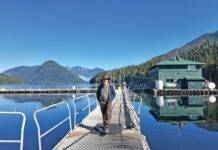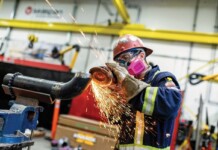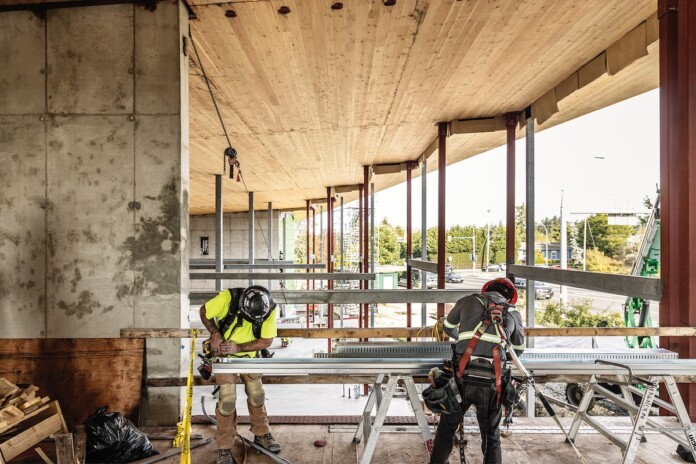
Construction doesn’t sleep, not even on holidays. Around Greater Victoria, carpenters pound away at new homes, concrete trucks rumble down the road and labourers erect scaffolding at commercial projects. In these times of global trade wars, perpetual price hikes and labour uncertainty, those who work at and manage construction sites face tight deadlines and tighter budgets. They may be building solid structures, but shifting business conditions require constant vigilance.
“The next two years will be very challenging for construction,” predicts Chris Gardner, president of the Independent Contractors and Businesses Association of B.C. “This is the most I’ve been concerned since I joined ICBA in 2017.”
From bureaucracy to bidding, costs to conditions, the local construction industry is facing multiple challenges. How it manages them will determine its success.
The Price of Red Tape
The hammering is coming from multiple fronts. Off the top of his head, Gardner cites drawn-out permitting/approvals for work and heavy taxes or municipal levies at each step of the project that, despite repeated calls for affordable housing, continue to layer on steep costs and long lead times.
“It can take up to four years to get a highrise approved,” says Gardner, whose organization represents over 4,000 companies in the open-shop construction industry. “Instead of municipal staff micromanaging a project every step of the way, project architects and engineers should be used until the final stages, when municipal staff would step in.”
Bundled into municipal approvals is the B.C. Building Code 2024 that mandates pricey seismic design and adaptable dwelling features, targeted at aging and handicapped residents. “Every time they change the building code, it adds more costs,” Gardner says.
“Sure, they [the buildings] can withstand the worst earthquake, but you can’t afford to build them,” says John Knappett, chairman and founder of the Knappett Group. “While buildings constructed today are superior to those from two decades ago, if tenants or owners cannot afford them, what’s the point?”
Market Transition
Knappett, an engineer, formed his company in 1983 and since then, hundreds of civil, industrial, commercial, institutional, residential and historical projects have been completed by the Victoria firm, which can employ up to 200 workers.
Through the mid-summer and into fall, his company was building 200 units of housing for the Cowichan Tribes in Duncan, an Esquimalt public safety building, a firehall in Saanich, a bridge in Langford, a school in Courtenay and 70 units of social housing in Saanich. “A lot of projects are being completed,” says Knappett. “But there’s not as much work as three years ago.”
 Continued uncertainty around tariffs and their effects on the B.C. economy has led to a subdued real estate market and with that, a slowdown on new builds due to further unpredictability around return on investment and profit margins.
Continued uncertainty around tariffs and their effects on the B.C. economy has led to a subdued real estate market and with that, a slowdown on new builds due to further unpredictability around return on investment and profit margins.
With 42 years in the industry, Knappett is seeing multi-family rental housing upending the condo market, as soaring construction costs and cash-strapped buyers leave unsold units piling up. “The condo market has diminished greatly,” he says. Meanwhile, rental housing stock is growing.
Over the 12 months to June 2025, there were roughly 108,000 rental unit starts across the country, according to the Canada Mortgage and Housing Corporation.
That’s nearly double the figure for condo units.
Knappett is skeptical of some federal fixes including the Build Canada Homes initiative that promises faster, prefabricated and modular homes in a bid to supply affordable housing up to 50 per cent faster. His company has completed a few such projects and the time savings are debatable. In Esquimalt, a five-year project saw most of those years eaten up by land acquisition, rezoning, design and securing building permits. The actual building took about three months. “It would be far simpler to shave it off the development end,” Knappett says of the 57 months of pre-construction time.
And when it takes 60 months to produce even basic housing, “What’s the world going to be like in five years? It all becomes very risky and with risk, comes cost,” Knappett points out. That long project time explains the current condo quandary.
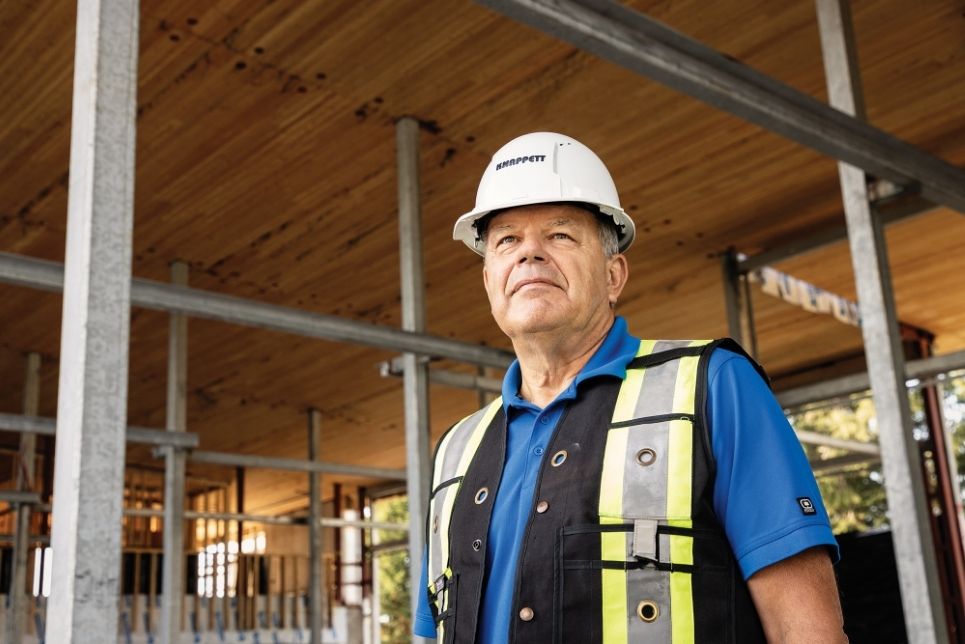
Tariffs and Tenders
Knappet says that while Canadian lumber may account for 25 per cent of a building’s material, most of the other components — windows, doors, electrical, plumbing and more — are imported from the U.S. The majority of those goods coming into Canada have not faced tariffs until recently. But new tariffs, along with tariffs the U.S. is placing on goods from China like electrical panels or plumbing fixtures, mean some items are hit twice before they land on a Canadian job site.
Another challenge is the presence of national construction giants like Bird, Ellis-Don, Ledcor, PCL and Pomerleau, who are winning local bids at least partly on the basis of how government procurement models are structured. Knappett used the example of bidding to design/build a school in Langford. Only companies that have built five seismically designed schools in the last five years are considered. A point-based scoring system is now used and the project price is not even factored into the evaluation, he says.
In 2014, Knappett completed the 443 Maritime Helicopter Squadron base near Victoria International Airport, a three-year project and the largest single building on the Island. “It was built on time and on budget,” Knappett says. But with today’s procurement model, he says his company would not have had a winning bid due to the scoring system. “There’s always somebody dreaming up a better procurement method,” he says. “Eventually, we’ll be like the food industry with three companies controlling construction.”
Another government initiative, which Gardner says is leading to budget overruns and missed completion dates, is the provincial Community Benefits Agreement (CBA). Unveiled in 2018 by then-premier John Horgan, the CBA requires workers on some projects to join one of 19 unions under the Allied Infrastructure and Related Construction Council (AIRCC) umbrella. Roughly 30 per cent of B.C. construction workers belong to AIRCC members. “When you cut out a large percentage of companies, it drives up costs,” Gardner says. He points to the new Cowichan District Hospital, where the initial budget of $887 million has almost doubled to $1.45 billion with the 2026 completion date now forecast for 2027.
Phil Venoit holds local governments, not the province, responsible for construction challenges. “Municipal government is the one that ties up development,” says Venoit, an electrician and the business manager for the International Brotherhood of Electrical Workers Local 230. “They contribute to higher prices and cause bottlenecks.” Like Knappett, Venoit says the vast majority of projects on the Island entail multi-family residential, which are at the mercy of municipal mandates and development-cost charges regimes.
Layers of Cost
Casey Edge, executive director of the Victoria Residential Builders Association, is well acquainted with the ongoing battles faced by his members. “The new seismic regulations for multi-family dwellings add 15 to 20 per cent for new projects and that’s just one thing,” he says. As well, the B.C. Building Code, in addition to amped-up costs, can cause unintended damage. “Mandating very energy-efficient homes draws radon gas into a structure,” Edge says, referring to reduced air exchange in modern, air-tight homes.
One further cost-enhancer is the property transfer tax, which applies to most instances of purchasing or gaining an interest in a property. At each step of a project, the tax is applied, be it when land is bought, subdivided, sold and when the home is finally built and sold. Exemptions exist, but for the most part the property transfer tax is a revenue source for the provincial government, raising roughly $2 billion annually for the province, while making homes more expensive, says Edge.
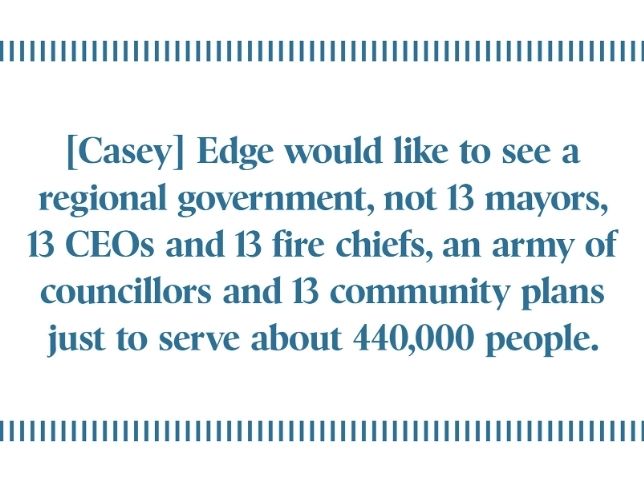
He also cites the glaring inconsistencies within Greater Victoria’s municipalities and their home-building efforts. The CMHC estimates that, nationally, housing starts must nearly double to around 430,000 to 480,000 units per year until 2035 to meet projected demand.
Edge isn’t optimistic the goal will be reached. A public that opposes development in their particular neighbourhoods, municipal staff that take months to grant a minor approval and municipalities like North Saanich and Metchosin that “get a pass” all add further challenges, he says, “while Colwood and Langford are building over 50 per cent of the homes.” Repeated attempts to get comment from the District of North Saanich went unanswered.
In Oak Bay, which has faced criticism over its lack of new housing, Mayor Kevin Murdoch says in his municipality there are about 45 new housing units in the building permit approval or construction pipeline. And it wasn’t until 2025 that Oak Bay introduced both development cost charges (DCCs) and amenity cost charges (ACCs). A new 3,000-square-foot home in Oak Bay would be subject to $16,747 for DCCs for infrastructure and $6,441 for ACCs for community facilities, totalling $23,188.
Edge would like to see a regional government, not 13 mayors, 13 CEOs and 13 fire chiefs, an army of councillors and 13 community plans just to serve about 440,000 people.
Plans vs. Progress
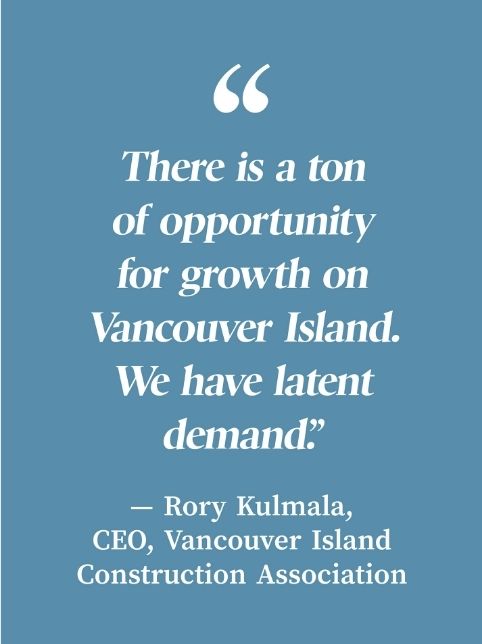 The CEO of the Vancouver Island Construction Association has a more bullish view. “There is a ton of opportunity for growth on Vancouver Island. We have latent demand,” says Rory Kulmala. New infrastructure is one pressing area and foremost is transportation and the indisputable need for a regional strategy that connects Greater Victoria. In 2011, a transportation project involving B.C. Transit was pegged at $400 million; today, the price tag is $1.5 billion, Kulmala says. “The cost of not doing something now will be extremely high,” he says.
The CEO of the Vancouver Island Construction Association has a more bullish view. “There is a ton of opportunity for growth on Vancouver Island. We have latent demand,” says Rory Kulmala. New infrastructure is one pressing area and foremost is transportation and the indisputable need for a regional strategy that connects Greater Victoria. In 2011, a transportation project involving B.C. Transit was pegged at $400 million; today, the price tag is $1.5 billion, Kulmala says. “The cost of not doing something now will be extremely high,” he says.
Other projects that should be breaking ground include Rock Bay redevelopment, Esquimalt DND base upgrades, airport and cruise-ship-terminal expansions, a major convention centre and UVic housing along with more medium-to-high-density housing and family-oriented homes.
Like Edge, Kulmala says a regional strategy needs to be implemented. But when VICA proposes ideas to various levels of government, it’s a one-way conversation. “We give them a list of 25 ideas. There’s a lot of head-nodding,” he says. In the end, bureaucrats give reasons why projects cannot be started. “A bike lane can appear in three months, but a small housing project takes four years,” Kulmala says. And once a project is eventually approved, he says that development cost charges, used by municipalities to fund public works, grow out of control. Kulmala would like to see a moratorium on DCCs.
The likelihood of such a suspension is unlikely, given that municipalities like Saanich use them to pay for upgrades to sanitary, water, drainage and transportation systems as well as to buy and develop parkland.
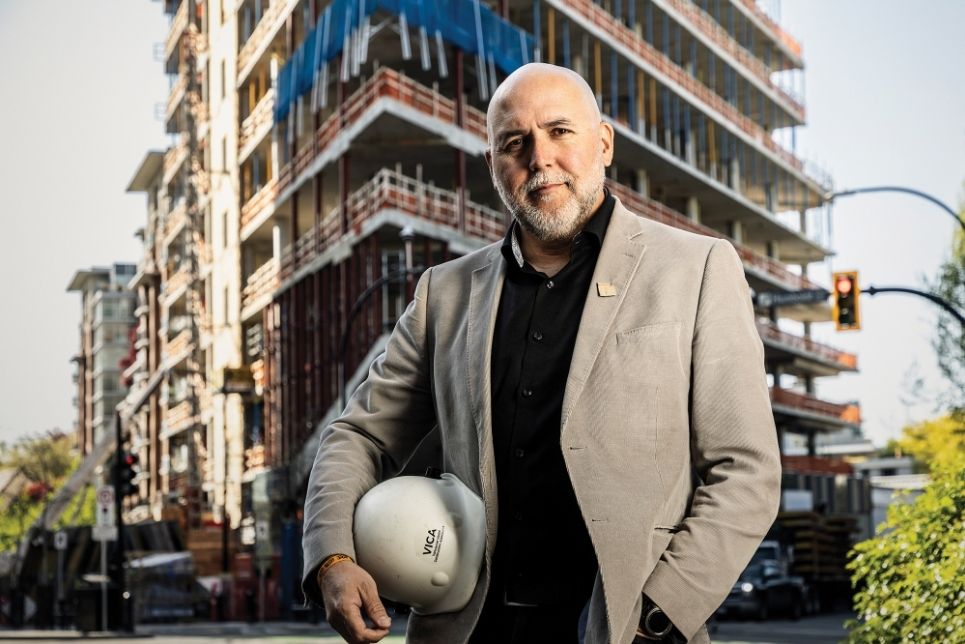
Changing Culture
A positive sign emerging in the industry is the increase of respect it is receiving and its growing diversity. Venoit points out that while there are a good number of electricians, with retirements looming more will be needed. And women have been plugging in. “We are seeing a rise in female apprentices in all areas, but definitely in electricians. There are 30 female electricians at the Cowichan hospital project,” Venoit says.
Twenty per cent of those working in construction are aged 55 or over while only three per cent of those who graduate from high school enter trades training within five years, Gardner adds. Even though the need for more tradespeople is old news, schools haven’t seriously addressed the issue or added sufficient funding to train the people needed to “Build, baby, build.”
Not that more can’t be done: Edge, of the residential builders association, says making the trades an attractive career option is imperative — to get more young people trades-bound, he’s got an unconventional idea. Many university students graduate without hands-on skills, so Edge proposes they take electives in subjects like welding or carpentry. “It would enable them to have summer jobs and create a more well-rounded education,” he says. The training wouldn’t undermine their major, but could awaken a desire to become an electrician instead of a middle manager.
Improved work conditions are another bright spot, with WorkSafeBC’s October 2024 requirement mandating that all work sites with 25 or more people have flush toilets, running water and sinks on site. “It’s been a real game-changer,” Venoit says. He recalls how it was a few years ago, when entering what in effect was an outhouse was often an unpleasant experience. “There’s nowhere to hang your jacket. You’re standing in mud, or you hope it’s mud,” Venoit says.
Building the Vision
It’s unlikely costs will substantially fall in an industry where unrelenting innovation must co-exist with the unpredictable human dynamic. But despite rising costs, shifting regulations and growing uncertainty, the Island’s construction industry keeps moving.
“Building is way more complicated today,” Knappett says. “But it’s what we do. We all have to adapt and change.”
Even as technology evolves and policy debates continue, the core of construction remains unchanged, with skilled people turning vision into reality. “At the heart of it, we still drive nails into boards. The roofers, the skilled trades, they’re still most important.”
And as Kulmala knows, while less-than-blue-sky conditions are the norm, he still sees opportunity on the horizon. “We’re used to working with that cloud over our heads,” he says.







